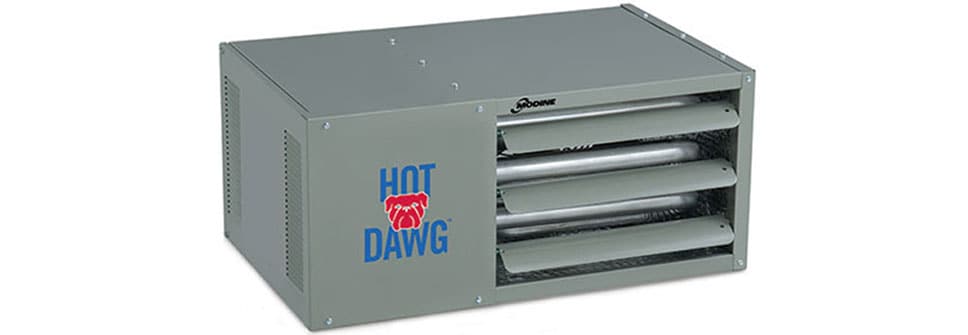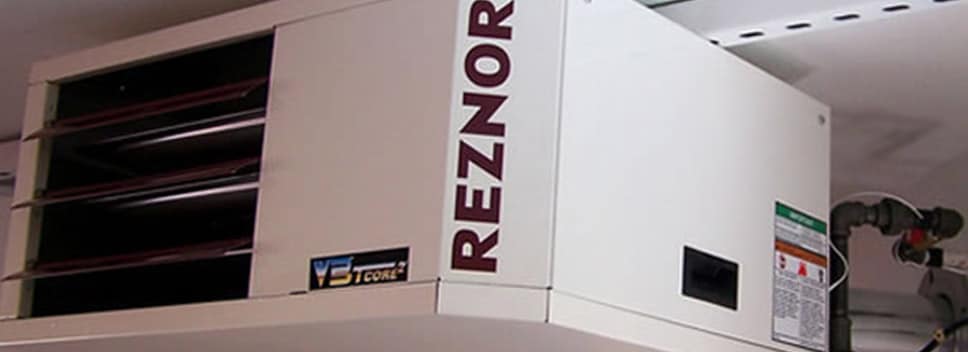
For many, a garage is more than just a storage space for cars. It’s a workshop where they can tinker with tools or develop their woodworking hobby. Maybe it’s an entertainment room to host watch parties and receive guests.
Unfortunately, Jack Frost usually brings an end to recreational garage use until the spring, but it doesn’t have to be that way.
Although there are several ways to heat a garage, none match the safety, simplicity, or affordability of garage unit heaters. Keep reading to learn why they are the best way to heat a garage.
Garage unit heaters, or garage heaters, are compact, permanently installed heating units that are mounted on the wall or ceiling and vented outside to provide a simple and safe source of warmth. They come in a variety of fuel types and flexible installation options.

Compare that with the common portable heaters many people use in their garage. Not only do you have to keep replacing the fuel (if it’s gas or propane powered), but you’re not effectively heating the entire garage.
Add to that the potential danger from exhaust fumes that leak directly into your airspace because they are supposedly at “acceptable” levels and don’t require venting. Even if you’re fine with breathing in this “acceptable” level, what happens if something malfunctions and the heater starts releasing dangerous amounts?
Garage unit heaters avoid these problems by using a constant flow of fuel and venting exhaust gases outside.
Other garage heating options include underfloor radiant heating, infrared heaters and mini splits.
Radiant heating is excellent, however, it’s very expensive to set up. Unless you’re doing new construction, you’ll need to jackhammer your entire garage floor to install the radiant tubing. For hydronic radiant heat, you’ll also need an existing boiler system to heat the water flowing through the pipes.
Infrared heaters use radiation to heat objects in the room, including your body. Although they are quiet, relatively simple to install, and provide comfortable heat, they sometimes struggle with evenly heating the space. Also, the infrared heat can damage the paint on your car if it’s parked inside the garage.
Ductless mini splits are another excellent source of heat; however, cooling is their primary function. Because they can heat and cool, mini splits are more expensive than garage unit heaters. Mini splits also require an outdoor compressor with a line set connecting to the indoor fan. Finally, mini splits may struggle to effectively heat a space if temperatures are consistently below zero.
So, if safe, consistent, affordable heating is your goal, then a unit heater is the best way to heat a garage. Now we’ll cover the various fuel, venting, and installation options you have with garage heaters.
Name the fuel type, and chances are there is a garage heater that can use it. The available fuel types are:
You should choose between the above fuel types depending on what is most available or affordable in your area, so make sure to do your homework. For example, if you live near a hydroelectric dam, then you can likely power an electric garage heater cheaply. In fact, many garage hobbyists prefer electric garage heaters because they are the simplest to install and operate.

In some instances, the decision can almost be made for you. For example, if you already use a boiler to heat your house, then a hydronic garage heater is the rational choice.
Of course, for any fuel type, you will need to make sure you have a fuel line running to your garage. This may mean getting a plumber to run a gas line or an electrician to install the proper wiring. For some applications, this can substantially increase the installation costs, so check before buying.
Most residential garage heaters are installed horizontally on the ceiling, meaning the warm air blows across the room instead of straight down. The exact installation location and orientation is up to you and your installer and will depend on your garage size and the number of obstructions present.
In some applications, the garage heater is installed so that it blows warm air across the garage door, preventing cold air from entering at the source. In other applications, the garage heater is installed in a corner of the garage and blows warm air diagonally across the space.

Still other applications have the heater installed opposite the garage door blowing straight. Besides ceiling-mounted garage heaters, wall-mounted and suspended options exist that are less common in residential applications. Most heaters include fins or louvers that can be adjusted to alter the direction of airflow.
The default temperature control for most garage heaters is a built-in thermostat on the unit. If you don’t want to climb a ladder every time you set the temperature, you can wire standard thermostats and smart remote thermostats to control it.
Remember that one of the benefits of garage heaters is that they vent all the toxic emissions outside, thereby safeguarding your indoor air.
When it comes to venting, there are two recommended methods:
Power venting draws air for combustion from inside the garage and uses a motor to directly exhaust fumes through a pipe that runs out the wall or ceiling. It’s a great option for most residential applications.
The only time we don’t recommend using power venting is when your garage air contains sawdust, paint chemicals, or other pollutants. You don’t want these impurities getting drawn into your heater.
Direct (Separated Combustion) Venting is recommended for garages with poor indoor air quality, where you do things like woodworking or paint spraying. Not only does direct venting exhaust directly outside, but it also brings in fresh combustion air directly from the outdoors.
You can use our HVAC sizing calculator to get a rough idea of how many BTUs your unit heater will need to produce to keep your garage warm.
You should not use that estimate as a replacement for a Manual J Load calculation done by a professional contractor, who will take all aspects of heat loss into consideration. Oversizing or undersizing a garage heater will either waste a ton of energy or keep you shivering.
With a garage unit heater, you can reclaim your garage during winter and turn it into a 24/7/365 dwelling place. Whether it's a woodshop, man cave, or she-shed, your garage will be just as comfortable in January as it is in May.
If you need help finding the right garage heater, please contact us, and we'll be happy to assist you.